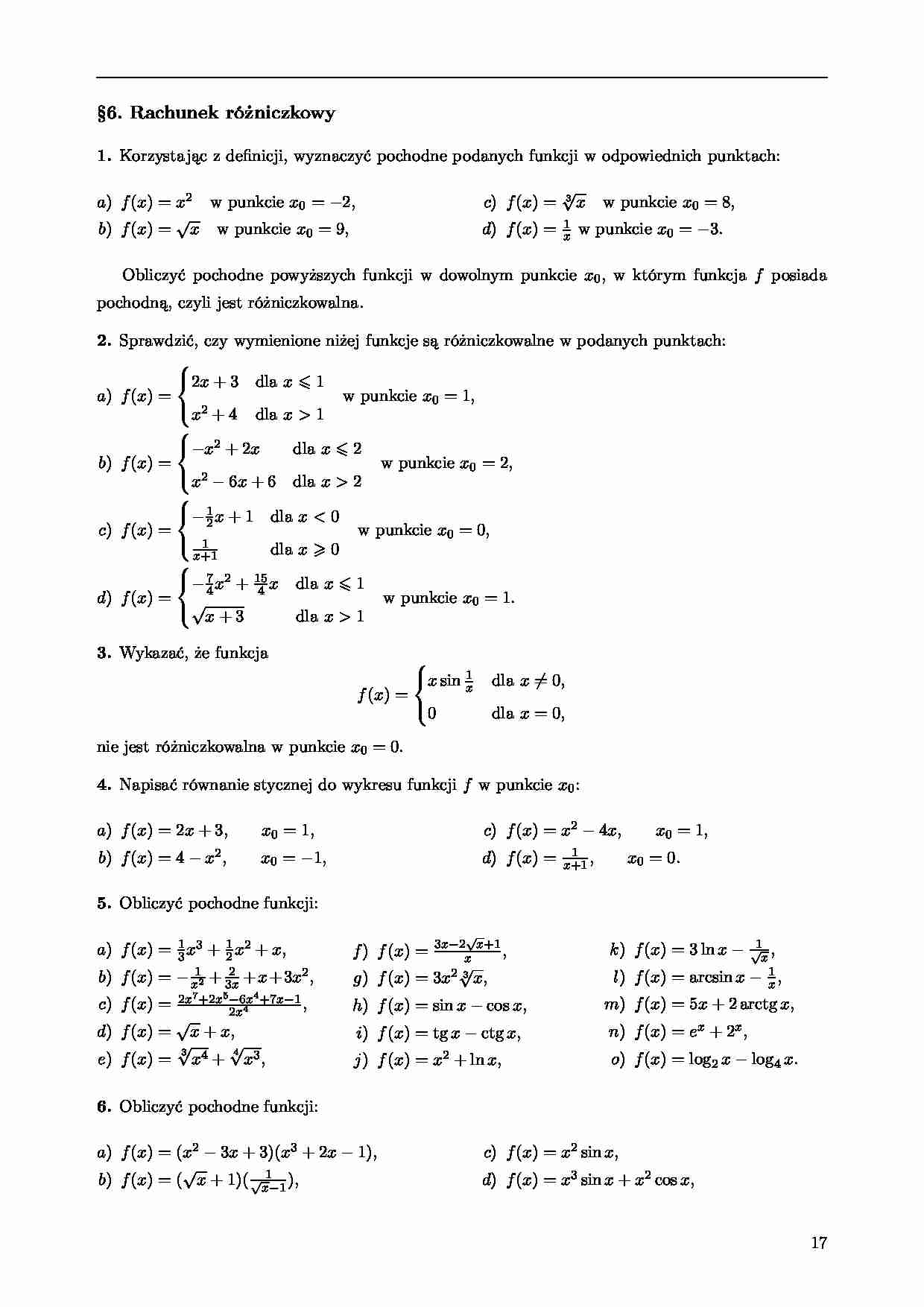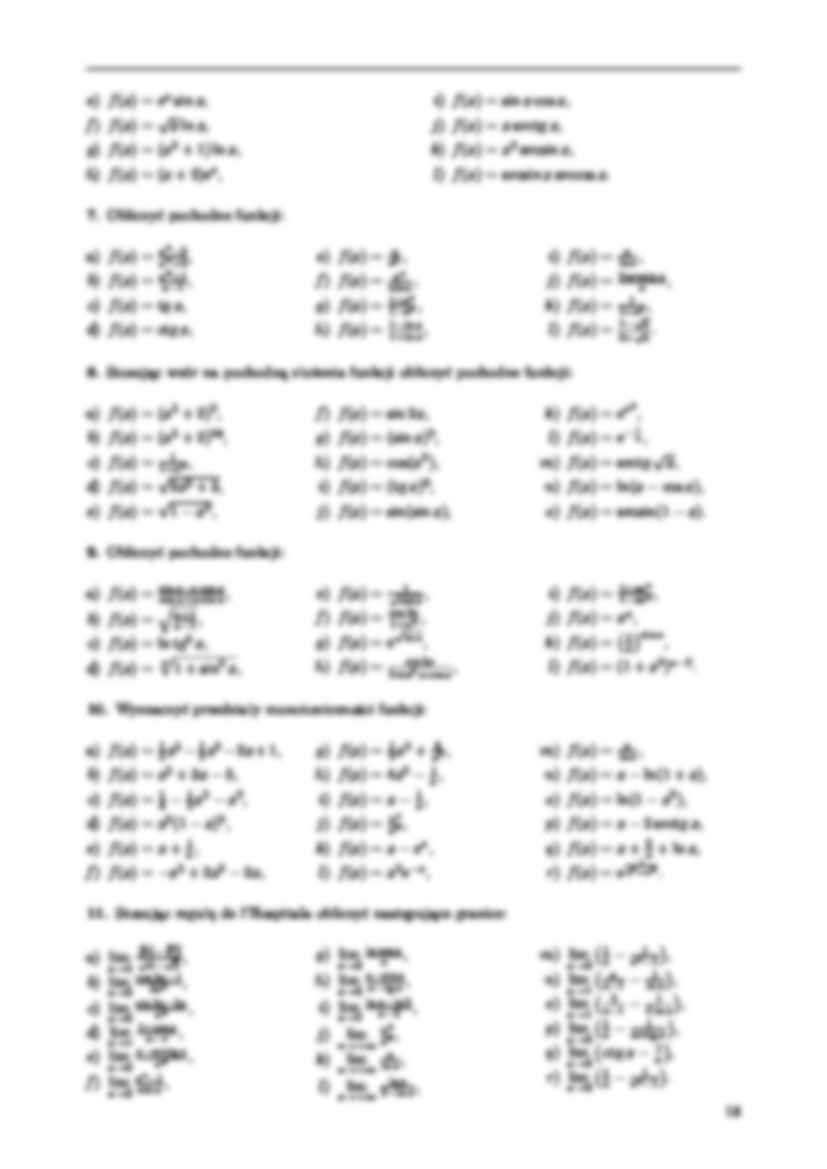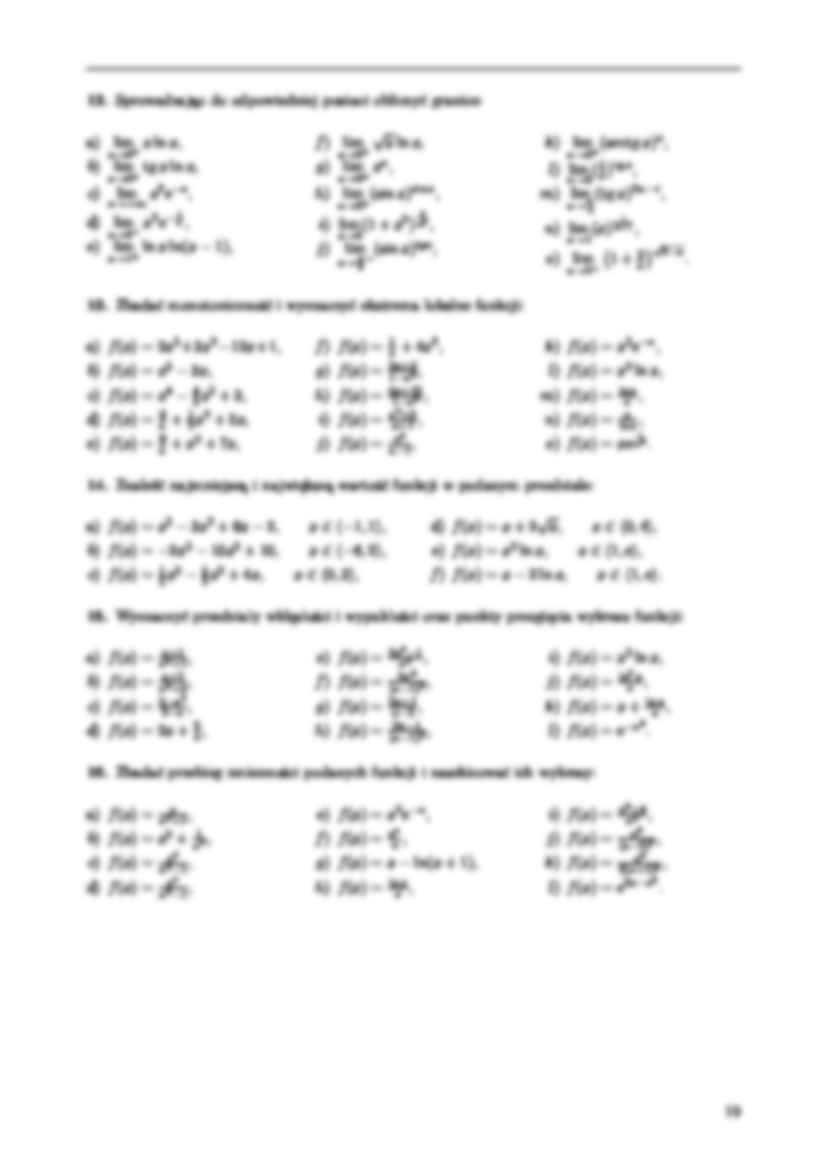


Fragment notatki:
§6. Rachunek różniczkowy
1. Korzystając z definicji, wyznaczyć pochodne podanych funkcji w odpowiednich punktach:
c) f (x) =
√
3
x w punkcie x0 = 8,
d) f (x) =
a) f (x) = x2 w punkcie x0 = −2,
√
b) f (x) = x w punkcie x0 = 9,
1
x
w punkcie x0 = −3.
Obliczyć pochodne powyższych funkcji w dowolnym punkcie x0 , w którym funkcja f posiada
pochodną, czyli jest różniczkowalna.
2. Sprawdzić, czy wymienione niżej funkcje są różniczkowalne w podanych punktach:
2x + 3 dla x 1
a) f (x) =
w punkcie x0 = 1,
x2 + 4 dla x 1
−x2 + 2x
dla x 2
b) f (x) =
w punkcie x0 = 2,
x2 − 6x + 6 dla x 2
− 1 x + 1 dla x 1
3. Wykazać, że funkcja
x sin 1
x
f (x) =
0
dla x = 0,
dla x = 0,
nie jest różniczkowalna w punkcie x0 = 0.
4. Napisać równanie stycznej do wykresu funkcji f w punkcie x0 :
a) f (x) = 2x + 3,
b) f (x) = 4 −
x2 ,
c) f (x) = x2 − 4x,
x0 = 1,
x0 = −1,
d) f (x) =
1
x+1 ,
x0 = 1,
x0 = 0.
5. Obliczyć pochodne funkcji:
a) f (x) = 1 x3 + 1 x2 + x,
3
2
f ) f (x) =
2
1
b) f (x) = − x2 + 3x +x+3x2 ,
g) f (x) =
c) f (x) =
2x7 +2x5 −6x4 +7x−1
,
2x4
√
d) f (x) = x + x,
√
√
3
4
e) f (x) = x4 + x3 ,
√
3x−2 x+1
,
x
√
3x2 3 x,
k) f (x) = 3 ln x −
l) f (x) = arcsin x
1
√ ,
x
1
− x,
h) f (x) = sin x − cos x,
m) f (x) = 5x + 2 arctg x,
i) f (x) = tg x − ctg x,
n) f (x) = ex + 2x ,
j) f (x) = x2 + ln x,
o) f (x) = log2 x − log4 x.
6. Obliczyć pochodne funkcji:
a) f (x) = (x2 − 3x + 3)(x3 + 2x − 1),
√
1
b) f (x) = ( x + 1)( √x−1 ),
c) f (x) = x2 sin x,
d) f (x) = x3 sin x + x2 cos x,
17
e) f (x) = ex sin x,
√
f ) f (x) = x ln x,
g) f (x) =
(x2
i) f (x) = sin x cos x,
j) f (x) = x arctg x,
k) f (x) = x2 arcsin x,
+ 1) ln x,
h) f (x) = (x + 2)ex ,
l) f (x) = arcsin x arccos x.
7. Obliczyć pochodne funkcji:
a) f (x) =
b) f (x) =
x2 −2
,
x2 +2
x3 +1
x−1 ,
e) f (x) =
f ) f (x) =
c) f (x) = tg x,
g) f (x) =
d) f (x) = ctg x,
h) f (x) =
x
ex ,
ex
sin x ,
1+ex
1−ex ,
1−ln x
1+ln x ,
i) f (x) =
j) f (x) =
k) f (x) =
l) f (x) =
x
ln x ,
2 arcsin x
,
x
1
1+ex ,
√
1−√x
.
2+ x
8. Stosując wzór na pochodną złożenia funkcji obliczyć pochodne funkcji:
2
a) f (x) = (x3 + 2)2 ,
f ) f (x) = sin 2x,
k) f (x) = ex ,
b) f (x) = (x3 + 2)24 ,
g) f (x) = (sin x)2 ,
l) f (x) = e− x ,
h) f (x) = cos(x2 ),
m) f (x) = arctg
i) f (x) = (tg x)6 ,
n) f (x) = ln(x − cos x),
j) f (x) = sin(sin x),
o) f (x) = arcsin(1 − x).
c) f (x) =
d) f (x) =
e) f (x) =
1
,
1+x2
√
2
2x
√
+ 3,
1 − x2 ,
1
√
x,
9. Obliczyć pochodne funkcji:
a) f (x) =
b) f (x) =
c) f (x) =
d) f (x) =
sin x−x cos x
cos x+x sin x ,
x+1
x−1 ,
ln tg2 x,
x
1 + sin2 x,
e) f (x) =
f ) f (x) =
g) f (x) =
h) f (x) =
√1 ,
cos x
cos 2x
,
1+x2
√
ln x ,
e
i) f (x) =
j) f (x) =
k) f (x) =
sin 3x
,
2 sin2 x cos x
l) f (x) =
1+xex
1−xex ,
xx ,
1 sin x
,
x
2 )x−2 .
(1 + x
10. Wyznaczyć przedziały monotoniczności funkcji:
1
a) f (x) = 3 x3 − 1 x2 − 2x + 1,
2
1
g) f (x) = 2 x2 +
b) f (x) = x3 + 3x − 5,
h) f (x) = 4x2 −
c) f (x) =
1
4
−
1 3
3x
−
x2 ,
d) f (x) = x2 (1 − x)2 ,
e) f (x) = x +
f ) f (x) =
−x3
1
x,
+
i) f (x) = x −
j) f (x) =
− 2x,
l) f (x) =
1
x,
x4
ex ,
k) f (x) = x −
2x2
8
,
x2
1
x,
m) f (x) =
x
ln x ,
n) f (x) = x − ln(1 + x),
o) f (x) = ln(1 − x2 ),
p) f (x) = x − 2 arctg x,
ex ,
x2 e−x ,
q) f (x) = x +
r) f (x) = e
2
x
1
x2 −x3
+ ln x,
.
11. Stosując regułę de l’Hospitala obliczyć następujące granice:
√
√
3 x− 3 3
√ √ ,
x→3 x− 3
3x−1
lim cos5x2 ,
x→0
lim sin 3x−3x ,
x3
x→0
1+cos x
lim
,
x→π x−π
x−arctg x
lim
,
x3
x→0
ex −1
lim
,
x→0 sin x
ln cos x
x ,
lim x−sin x ,
x→0 x−tg x
lim ln x−ln 2 ,
x→2 x−2
2
lim xx ,
x→+∞ e
lim x ,
x→+∞ ln x
lim ln x ,
x→+∞ 2−ln x
a) lim
g) lim
m) lim
b)
h)
n) lim
c)
d)
e)
f)
x→0
i)
j)
k)
l)
x→0
x→1
o) lim
x→1
p) lim
x→0
q) lim
x→0
r) lim
x→0
1
x
1
ex −1 ,
x
1
x−1 − ln x ,
3
1
x−1 − 2 ln x ,
1
1
x − arctg x ,
1
ctg x − x ,
1
1
x − ex −1 .
−
18
12. Sprowadzając do odpowiedniej postaci obliczyć granice:
√
a) lim x ln x,
f ) lim
b) lim tg x ln x,
k) lim (arctg x)x ,
g) lim xx ,
x→0+
x→0+
x→0+
c)
x ln x,
x→0+
1
l) lim ( x )tg x ,
x→0+
lim x2 e−x ,
x→0
h) lim (sin x)sin x ,
x→+∞
m) lim (tg x)2x−π ,
π
x→0+
1
d) lim x2 e− x ,
i) lim (1 +
x→0−
x→0
e) lim ln x ln(x − 1),
j)
x→1+
x→ 2
2
1
x 2 ) x2 ,
n) lim (x) x−1 ,
x→1
lim (sin x)tgx ,
o) lim
x→ π −
2
x→2−
1+
2
x
√
2−x
.
13. Zbadać monotoniczność i wyznaczyć ekstrema lokalne funkcji:
a) f (x) = 2x3 +3x2 −12x+1,
f ) f (x) =
b) f (x) = x3 − 3x,
g) f (x) =
c) f (x) = x4 − 4 x3 + 3,
3
h) f (x) =
d) f (x) =
e) f (x) =
6
x
9
x
+ 1 x2 + 5x,
2
+
x2
+ 7x,
i) f (x) =
j) f (x) =
1
2
x + 4x ,
3x+5
,
1−x2
5x+13
,
1−x2
2 +3
x
x+1 ,
x2
x−1 ,
k) f (x) = x3 e−x ,
l) f (x) = x2 ln x,
m) f (x) =
n) f (x) =
ln x
x ,
x
ln x ,
1
o) f (x) = xe x3 .
14. Znaleźć najmniejszą i największą wartość funkcji w podanym przedziale:
a) f (x) = x3 − 3x2 + 6x − 2,
b) f (x) =
−2x3
−
15x2
+ 10,
1
c) f (x) = 3 x3 − 5 x2 + 4x,
2
√
d) f (x) = x + 2 x,
x ∈ −1, 1 ,
x ∈ −6, 2 ,
e) f (x) =
x ∈ 0, 3 ,
x2 ln x,
x ∈ 0, 4 ,
x ∈ 1, e ,
f ) f (x) = x − 2 ln x,
x ∈ 1, e .
15. Wyznaczyć przedziały wklęsłości i wypukłości oraz punkty przegięcia wykresu funkcji:
a) f (x) =
b) f (x) =
c) f (x) =
x+1
,
x2 +1
x+7
,
x2 +5
3−x2
2−x ,
2
d) f (x) = 2x + x ,
e) f (x) =
f ) f (x) =
g) f (x) =
h) f (x) =
2x2 −1
,
x2
2x3
,
(x−1)2
2x+1
x−3 ,
2x−1
,
(x−1)2
i) f (x) = x3 ln x,
j) f (x) =
k) f (x) =
l) f (x) =
ln2 x
x ,
x + ln x ,
x
−x3 .
e
16. Zbadać przebieg zmienności podanych funkcji i naszkicować ich wykresy:
a) f (x) =
b) f (x) =
c) f (x) =
d) f (x) =
x
,
x2 +1
2+ 1 ,
x
x2
x2
,
x2 −1
x4
,
x3 −1
e) f (x) = x2 e−x ,
i) f (x) =
ex
x,
j) f (x) =
g) f (x) = x − ln(x + 1),
k) f (x) =
f ) f (x) =
h) f (x) =
ln x
x ,
l) f (x) =
x3 +4
,
x2
x3
,
(x−2)2
3
x
,
2(x+1)2
2x−x2 .
e
19
... zobacz całą notatkę

Komentarze użytkowników (0)